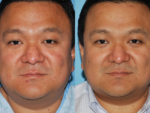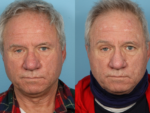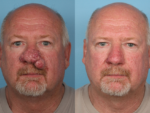What is Rhinophyma?
Rhinophyma is a benign condition of the nasal skin that results in abnormal growth and enlargement of the nose. While this is not cancerous, it results in a reddened, “bumpy” appearance of the nose that can be highly disfiguring. The etiology of this condition is multifactorial, but it is thought to represent advanced-stage rosacea that occurs in a minority of patients. However, while rosacea is more common in women, rhinophyma predominantly affects men.
The condition results in dilated blood vessels, chronic swelling and inflammation, and an increased number of sebaceous glands in the nose. This makes the nose appear reddened, thickened, and bulbous. There may also be prominent blood vessels and abnormal pitting and scarring of the skin. Alcohol and caffeine can exacerbate this condition.
In addition to being disfiguring, the significant enlargement of the nose may become so severe as to create or worsen nasal obstruction, making it difficult to breathe out of the nose. People with rhinophyma may also have skin cancers that are difficult to detect due to the diffusely abnormal appearance of the skin.
Who is a Candidate For Rhinophyma Surgery?
While there are medical treatments for rosacea, none of these has been found effective in patients with rhinophyma – surgery is the treatment of choice for this condition. Therefore, if the skin on your nose has enlarged and thickened to the point that it is affecting your quality of life or your self-esteem, a surgical procedure to reduce and reshape the outside of your nose may be a good option for you. In patients with moderate to severe rhinophyma, Dr. Sidle offers surgery to reduce the size and improve the appearance of the nose. For most patients, this surgery is life-changing and has a hugely positive impact on self-esteem and confidence in social situations.
What Does The Surgery Involve?
This surgery is an outpatient procedure that may be performed under sedation and generally does not require general anesthesia. Depending on the severity of the condition, surgery may take between 30 minutes and 2 hours. Dr. Sidle takes a multifaceted approach to the procedure, utilizing a progression of different tools to first remove the enlarged, irregular tissue and then smooth and contour the outside of the nose. A special bandage that is designed to keep the skin moist and reduce bleeding will then be placed over the nose. In most cases, just a single surgery is sufficient; however, in more severe cases, two procedures may be necessary to achieve the best possible result. When you come in for your consultation, Dr. Sidle will examine your nose and discuss what your anticipated treatment course will involve.
What can you expect after the surgery?
After you recover from anesthesia, you may go home. You will leave the dressing in place until you are instructed to remove it. Once it has been removed, your wound care will mostly entail keeping the wound clean and moist with ointment while it is healing. You will be able to notice the decreased size and improved shape of your nose immediately. However, due to the nature of the procedure, there will be some redness, bleeding, and drainage during the initial healing stages that occur in the first 2-3 weeks after surgery. Each patient’s healing is different, but in general, you should expect to achieve your “final appearance” approximately 2-3 months after your surgery.
How much does rhinophyma treatment cost?
Rhinophyma treatment can vary in price depending on the severity of the condition and the doctor’s office. Generally, insurance will cover a portion of the cost, but it is best to check with your carrier.
More Rhinophyma FAQs
Early-stage rhinophyma is typically treated with a combination of laser therapy and surgery. Laser therapy can help reduce the tumor size, while surgery can help remove any excess tissue. In more advanced cases, radiation therapy may also be used.
Yes, rhinophyma can be removed. It is a condition that affects the skin of the nose, causing it to thicken and darken. There are a few different treatment options available, including surgery, laser therapy, and radiation therapy.
Rhinophyma surgery typically lasts about two hours. The surgery is performed under a general anesthetic and usually takes one to two hours to complete. Recovery time is generally brief, with most people returning to normal activities within a few days. After the surgery, there may be some swelling and bruising, but this will dissipate in a few weeks.
Generally, rhinophyma will not come back after surgery. However, there is a slight chance that it could redevelop in some cases. Rhinophyma is a condition that causes the skin on the nose to become enlarged and red. It is most commonly seen in men who are middle-aged or older. Rhinophyma can be treated with surgery, but there is a risk that it may come back after treatment.
Rhinophyma treatment is usually covered by insurance. Insurance companies typically cover surgery and laser therapy for rhinophyma as long as the procedure is considered medically necessary. So if you’re diagnosed with rhinophyma, talk to your insurance company about coverage.
Rhinophyma treatment is not always surgical. A few different treatments can be used, depending on the severity of the condition. Laser therapy is often used to treat rhinophyma. This involves using a laser to remove the excess tissue from the affected area. Another option is dermabrasion, which uses a rotating brush to remove the top layer of skin. Surgery may also be necessary in some cases, mainly if the rhinophyma has caused significant disfigurement or if it is causing difficulty breathing.
A – Symptoms of rhinophyma include:
- Thick, swollen skin on the nose that is reddish or orange
- Bumps or pimples on the skin of the nose
- Drainage from the bumps, which may be thick, yellow, or greenish
- A change in the shape of the nose due to the thickened skin
Rhinophyma is a skin condition that causes the nose to become enlarged and bumpy. It is most commonly seen in men over 40 and is thought to be caused by excessive oil production and inflammation. There is no cure for rhinophyma, but it can be treated with topical or oral antibiotics, laser therapy, or surgery.
The most common treatment is surgery, but a few non-surgical treatments can also be used. One such treatment is laser therapy. Laser therapy uses high-intensity light to destroy the excess tissue on the nose. This treatment is often combined with other treatments, such as dermabrasion or steroid injections. Another possible treatment is radiation therapy. Radiation therapy uses X-rays or other types of radiation to kill the cells, causing the overgrowth of tissue on the nose. This treatment is typically only used when other treatments have failed or when there are complications from surgery.
Post-Operative Instructions
All post-operative instructions can be found on the Patient Resources page.
Our Results
Click Here to access our Before and After gallery for all procedures.
Chicago Rhinoplasty | Chicago Nose Job Surgeon | Chicago Nose Job Surgeries





